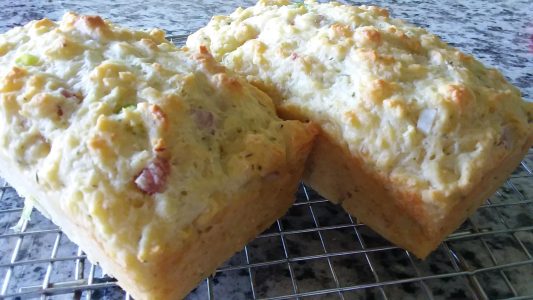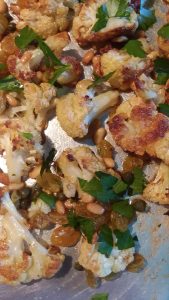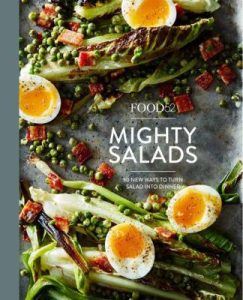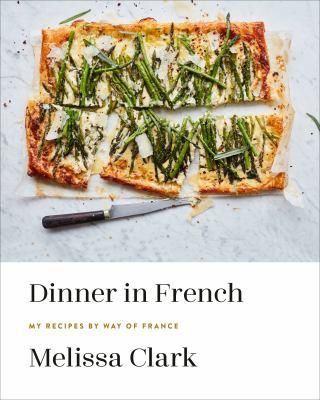Bibliobites in May: Comme Ci, Comme Ça
June 7, 2022 Book Reviews Library Staff
 What is it about French food that perpetually fascinates? Is it that European cultural savoir-faire, or the elegance we typically associate with France? Is it the food itself: not too challenging for most palates, often rich with butter and cheese; and accented with wine and herbs like tarragon or chives? Is it the vibrant personalities associated with some of its proponents, like Julia Child and Jacques Pépin? Perhaps all of the above? Whatever the lure, since Julia Child published Mastering the Art of French Cooking in the early 1960s, there's been a near constant parade of French cookbooks. Though Americans have often been derided for their love of quick and easy cooking (and their dependence on takeout), this enduring appeal of classic French cuisine tells a somewhat different story. This month our Bibliobites group took on la cuisine française with NY Times writer and author Melissa Clark's latest, Dinner in French.
Though Ms. Clark states in her introduction that her food is a merging of France and Brooklyn, there's a lot more of the former than the latter. There are twists on many iconic French dishes, but overall they are pretty firmly rooted in tradition. Interestingly, despite the general fascination with French food, most in our group aren't all that familiar with it, nor have we made many classic French dishes. As always, the way out of ignorance is knowledge, so how did it go in the kitchen?
As you might expect from a French cookbook, there's a chapter devoted to eggs, and one to cheese. Three people were intrigued by
What is it about French food that perpetually fascinates? Is it that European cultural savoir-faire, or the elegance we typically associate with France? Is it the food itself: not too challenging for most palates, often rich with butter and cheese; and accented with wine and herbs like tarragon or chives? Is it the vibrant personalities associated with some of its proponents, like Julia Child and Jacques Pépin? Perhaps all of the above? Whatever the lure, since Julia Child published Mastering the Art of French Cooking in the early 1960s, there's been a near constant parade of French cookbooks. Though Americans have often been derided for their love of quick and easy cooking (and their dependence on takeout), this enduring appeal of classic French cuisine tells a somewhat different story. This month our Bibliobites group took on la cuisine française with NY Times writer and author Melissa Clark's latest, Dinner in French.
Though Ms. Clark states in her introduction that her food is a merging of France and Brooklyn, there's a lot more of the former than the latter. There are twists on many iconic French dishes, but overall they are pretty firmly rooted in tradition. Interestingly, despite the general fascination with French food, most in our group aren't all that familiar with it, nor have we made many classic French dishes. As always, the way out of ignorance is knowledge, so how did it go in the kitchen?
As you might expect from a French cookbook, there's a chapter devoted to eggs, and one to cheese. Three people were intrigued by  savory gruyère bread with ham. This loaf made an excellent, cheesy snack or hors d'oeuvre, and it was also "great with a fried egg on top." The recipe came together easily, and it also freezes well. The idea of a savory loaf was new to many of us, but it's a keeper! Twice-baked cheese soufflés were a riff on the classic; with its multiple components it took "a lot of time." However it was tasty, "....not super-light, more like a cross between a souffle and a quiche." And speaking of the iconic quiche, sweet potato and bacon quiche with parsley turned out to be a good combination that "grew on me." It aged nicely, too.
Vegetables and salads went to France, as well: classic salade niçoise was delicious despite our cook's avoidance of the called-for olives and anchovies, "I did like it!" Shaved zucchini and melon salad with mint and almonds was an easy and refreshing accompaniment to many main dishes; but asparagus almondine was "too much work for asparagus!" We made a couple of heartier veggies, too:
savory gruyère bread with ham. This loaf made an excellent, cheesy snack or hors d'oeuvre, and it was also "great with a fried egg on top." The recipe came together easily, and it also freezes well. The idea of a savory loaf was new to many of us, but it's a keeper! Twice-baked cheese soufflés were a riff on the classic; with its multiple components it took "a lot of time." However it was tasty, "....not super-light, more like a cross between a souffle and a quiche." And speaking of the iconic quiche, sweet potato and bacon quiche with parsley turned out to be a good combination that "grew on me." It aged nicely, too.
Vegetables and salads went to France, as well: classic salade niçoise was delicious despite our cook's avoidance of the called-for olives and anchovies, "I did like it!" Shaved zucchini and melon salad with mint and almonds was an easy and refreshing accompaniment to many main dishes; but asparagus almondine was "too much work for asparagus!" We made a couple of heartier veggies, too:  roasted cauliflower with brown butter, raisins, and capers was a lovely combination with its raisins and capers. The brown butter added rich, savory notes. Sautéed cabbage with gruyère and jalapenos was a meal in itself, with hearty browned cabbage and plenty of cheese on top. The jalapenos added welcome heat.
Main dishes were of course on tap: roasted tarragon chicken with crispy mushrooms was "really good" with "nice tarragon flavor." Our cook added some potatoes to the roasting pan for a more complete, mostly hands-off meal. Two people tried beef daube with carrots and honey vinegar; depending on who made it, it was either "moist" or "too dry!" With a full bottle of red wine as the liquid, it had "a lot of flavor" and was "intense-- very rich." It might be too much of everything; it was "not a keeper." But, roasted tarragon shrimp and onions was definitely a keeper, "...my favorite! Absolutely delicious!" Hake with herb butter en papillote was another good choice; with copious amounts of butter it was "very rich." The fish and spinach stayed moist and tender inside their parchment packets. Almost-vegetarian lentil stew with garlic sausage and goat cheese was comforting and hearty with its salty, garlicky notes. Though it certainly wouldn't win any prizes in the looks department (notably, there was no photo of the finished dish), it was a tasty stew that improved in the fridge. A keeper! Pissaladière with tomato, olives, and anchovies was another mostly vegetarian hit. This Provençal take on pizza features caramelized onions which provided rich, savory flavor. The yeast dough was enriched with olive oil, which made it easy to work with. It was a bit of a production to make all the components, but "we really liked it;" even better, "it looked just like the photo!"
Despite several successes, on the whole, this title wasn't a huge hit. A couple of people thought the recipes involved way too much work for a weeknight; and we questioned whether most people would really want to dive into them on your average Tuesday night. And much of what we tried contained fair amounts of butter and/or cheese-- something you might not want in your regular weeknight rotation. We also thought it interesting that (in a "family dinner" book) many of the recipes were scaled for 6-8 servings rather than 4-6, though it was true that most made excellent leftovers. We did appreciate that the author gave detailed instructions on how to prep or make ahead either a whole dish or some of its components. Though Ms. Clark clearly loves France and French food, she failed to win any converts within our group (well, maybe one person!). As a result, our voting averaged out to a not-very-impressive 2.25 out of a possible 5. C'est la vie!
roasted cauliflower with brown butter, raisins, and capers was a lovely combination with its raisins and capers. The brown butter added rich, savory notes. Sautéed cabbage with gruyère and jalapenos was a meal in itself, with hearty browned cabbage and plenty of cheese on top. The jalapenos added welcome heat.
Main dishes were of course on tap: roasted tarragon chicken with crispy mushrooms was "really good" with "nice tarragon flavor." Our cook added some potatoes to the roasting pan for a more complete, mostly hands-off meal. Two people tried beef daube with carrots and honey vinegar; depending on who made it, it was either "moist" or "too dry!" With a full bottle of red wine as the liquid, it had "a lot of flavor" and was "intense-- very rich." It might be too much of everything; it was "not a keeper." But, roasted tarragon shrimp and onions was definitely a keeper, "...my favorite! Absolutely delicious!" Hake with herb butter en papillote was another good choice; with copious amounts of butter it was "very rich." The fish and spinach stayed moist and tender inside their parchment packets. Almost-vegetarian lentil stew with garlic sausage and goat cheese was comforting and hearty with its salty, garlicky notes. Though it certainly wouldn't win any prizes in the looks department (notably, there was no photo of the finished dish), it was a tasty stew that improved in the fridge. A keeper! Pissaladière with tomato, olives, and anchovies was another mostly vegetarian hit. This Provençal take on pizza features caramelized onions which provided rich, savory flavor. The yeast dough was enriched with olive oil, which made it easy to work with. It was a bit of a production to make all the components, but "we really liked it;" even better, "it looked just like the photo!"
Despite several successes, on the whole, this title wasn't a huge hit. A couple of people thought the recipes involved way too much work for a weeknight; and we questioned whether most people would really want to dive into them on your average Tuesday night. And much of what we tried contained fair amounts of butter and/or cheese-- something you might not want in your regular weeknight rotation. We also thought it interesting that (in a "family dinner" book) many of the recipes were scaled for 6-8 servings rather than 4-6, though it was true that most made excellent leftovers. We did appreciate that the author gave detailed instructions on how to prep or make ahead either a whole dish or some of its components. Though Ms. Clark clearly loves France and French food, she failed to win any converts within our group (well, maybe one person!). As a result, our voting averaged out to a not-very-impressive 2.25 out of a possible 5. C'est la vie!

 Our next meeting will be on Friday, June 24 at 11 AM. We'll meet in hybrid format; please register for either in-person or remote attendance. Since warmer days are here, we'll be cooking (assembling?) our way through two summery titles: The Complete Salad Cookbook from America's Test Kitchen, and Food52 Mighty Salads by the editors of Food52. Choose one or both; copies are available at the main circulation desk or via curbside pickup. See you on the 24th!
Our next meeting will be on Friday, June 24 at 11 AM. We'll meet in hybrid format; please register for either in-person or remote attendance. Since warmer days are here, we'll be cooking (assembling?) our way through two summery titles: The Complete Salad Cookbook from America's Test Kitchen, and Food52 Mighty Salads by the editors of Food52. Choose one or both; copies are available at the main circulation desk or via curbside pickup. See you on the 24th!

